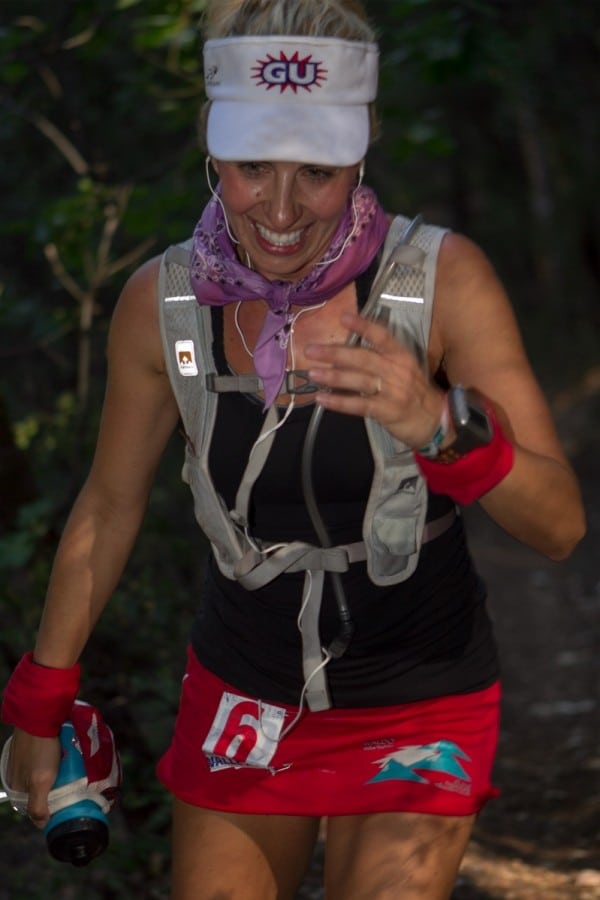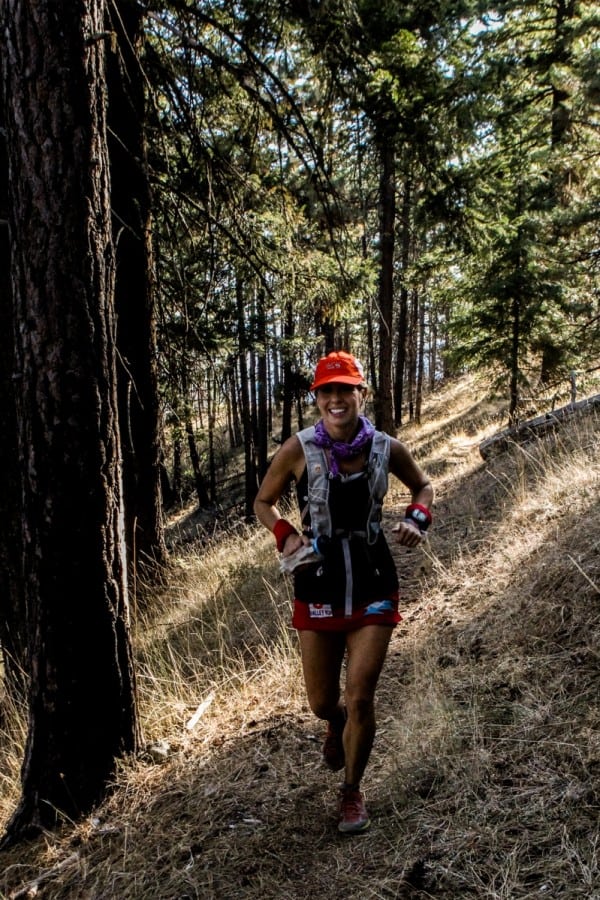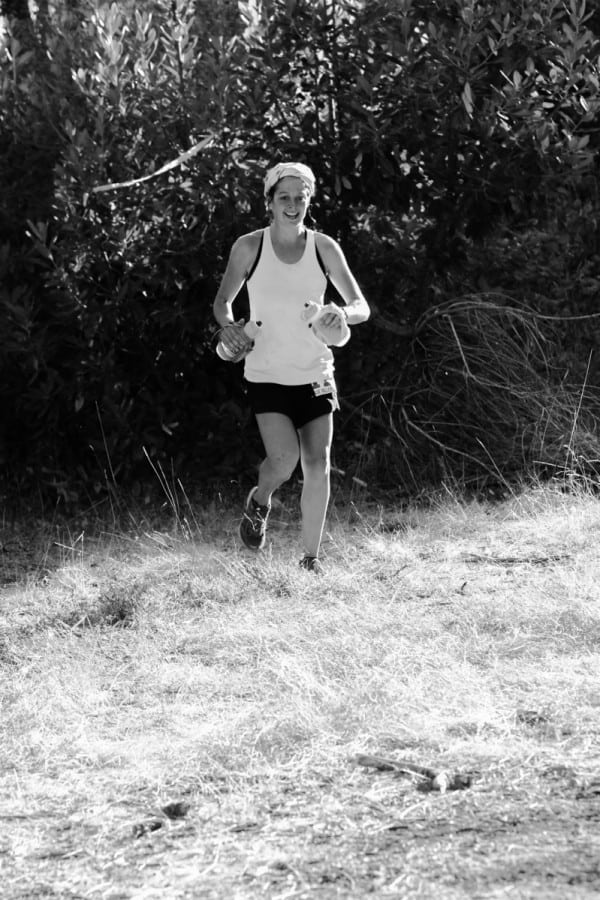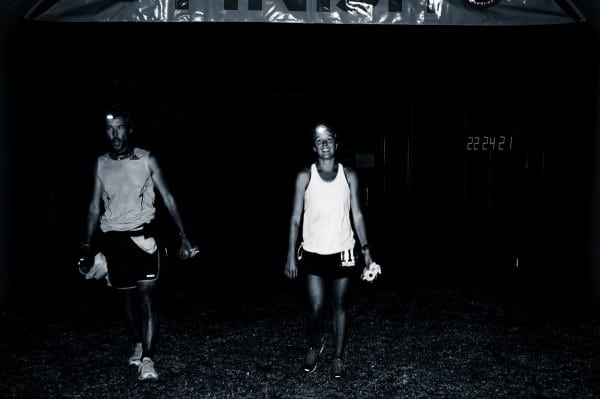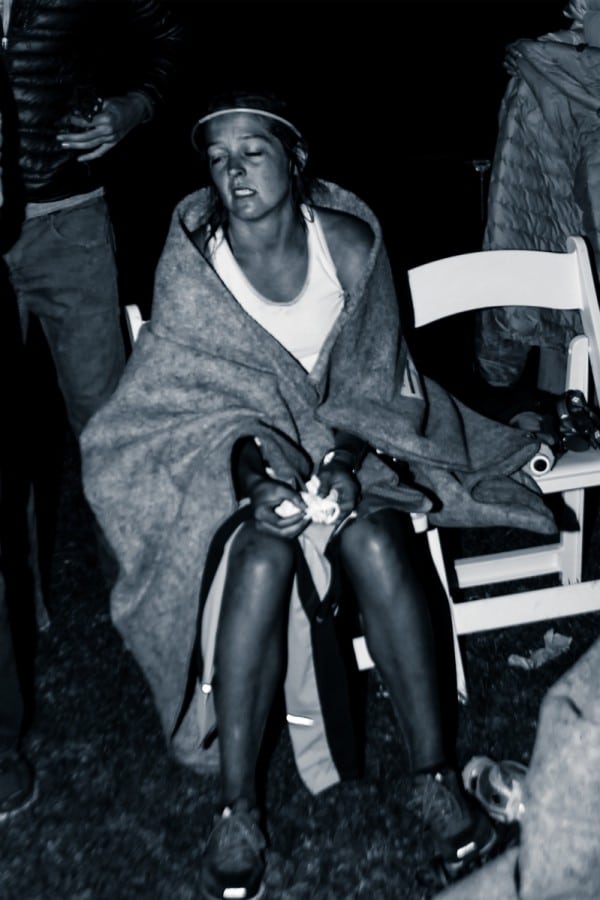I am there, at the 2012 Pine to Palm 100, as the photographer of record. As a photographer and runner (Though I am clearly undertrained these days and my last good, long run was three years ago.), I shoot these events with an eye that sees them from both sides and a heart that recognizes the pain in victory, the glory in just getting to the starting line, the courage to take the next step, and the gratitude of being welcomed as a participant in a crowd of people who run long as an act of faith and community.
The 2012 Pine to Palm starts at 6:00 am. Jenn Benna wears a white GU visor, a Waldo 100k finishers skirt, and a reasonably relaxed stance.
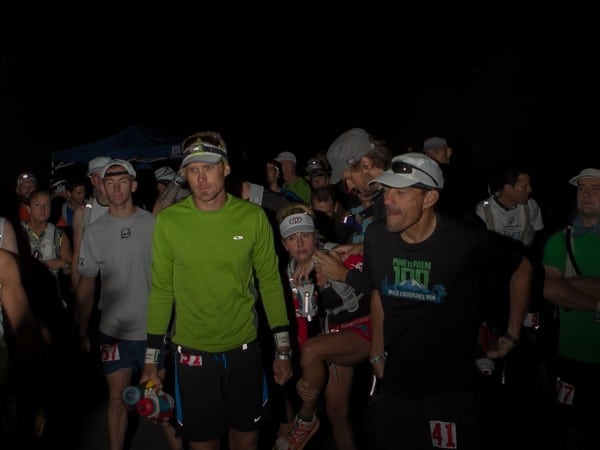
Jenn Benna (at center crouching) at the start of the 2012 Pine to Palm 100. All photos by Michael Lebowitz.
Thirty miles into the race, Jenn Benna cruises up Stein Butte. She looks easy in her stride and happy enough with how it is going to give a big hello smile to the photographer.
Here she is again at Hanley Gap, 50 miles in. She is comfortably in first place for the women, almost a half hour ahead of then-second-place woman Jenn Shelton.
Jenn Shelton is legendary among runners for her North American 100-mile time of 14:57:18; her exploits as chronicled in Born to Run, Christopher McDougall’s hagiographic embrace of the Tarahumara, Caballo Blanco, and barefoot running; and her take-no-prisoners approach to life.
My goal is to capture images of all the runners. Once I have done that I look for the moments, often in the late miles, in the early mornings, on the steeps, in harsh weather, when courage and fate are at hand, when all there is left to do is the doing, when there is only the runner and what he or she believes in to get them home.
I shoot right up until night falls. Any ultrarunner will tell you, I think, that the darkness changes everything. Primitive, ancient, the darkness brings fear and liberation all at once. For me it adds a different dimension. I am uncomfortable shooting with a flash on the trails after dark because of the shock it causes runners who are deep into their own worlds at that point; a place where a misstep is the end of the run; the end of months, years of training; the end, for a time, of a dream. In other words, my presence adds an element of danger and might change the reality of the event, violating my code as a teller of the tale as it happened and not a participant in the drama. I will let the philosophy majors debate the observer/observed dialectic that is involved. For me it is simple: don’t mess it up for the runners.
After dark, I go to the finish line, to see how the story unfolds. The finish line is about waiting, communications, and rumours. I try to grab some sleep. I never manage to do it.
This year the Pine to Palm winner comes in at 19-plus hours and is followed in reasonably close succession by five other runners. After that, the word is that Jenn Shelton will be the next to finish.
“100 miles is just plain hard,” Erik Skaggs says as we watch the trail for runners’ headlamps. I ask him if, when he raced ultras, he ran them against the other top runners or if his opponent was more elusive. He thinks about it and says that he enjoyed the company of the other runners, that they brought out his competitive drive, that he ran by himself most of the time, so he would have to say that he ran against and/or with himself mostly. Looking for the zone I ask, guessing. “Yeah,” he says, “the zone.” There is not much else to say. We wait quietly awhile longer.
As Erik and I talk, Shelton closes on the finish, about to be the women’s winner in a new course-record time. At 50 miles, she had fallen 28 minutes behind Jenn Benna. When I saw her then, she said the worst was behind her and she thought the night temperature would be good for her. Then Jenn Benna got lost at about 65 miles with Jenn Shelton having closed to within about 4 minutes.
Jenn Shelton finishes, flashes a smile, checks her time, and sits down.
After a while, she lies down to wait for Jenn Benna, the second-place female. She insists on being there to greet her.
I see Jenn Shelton and Jenn Benna, a hundred miles in their legs and bodies, every bit of it in their faces. They could have been young women growing old in the labor camps of Depression-era California, worn to bone, tired beyond their years. Indeed, a hundred miles is just plain hard.
